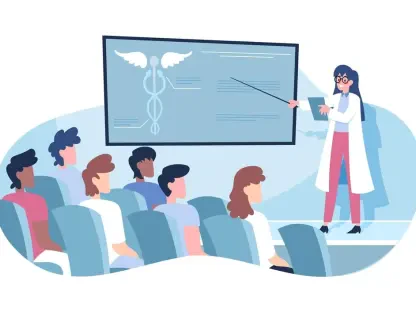Egypt stands at a pivotal moment in its healthcare evolution, with investments soaring to unprecedented levels and a vision to transform into a regional health powerhouse that attracts attention across the Middle East and Africa. Recent data reveals that the nation is spearheading 1,300 health projects valued at EGP 177 billion, a figure that underscores an ambitious drive to overhaul infrastructure and elevate care standards. This surge is not merely about numbers; it reflects a deeper commitment to sustainability, universal access, and technological innovation, positioning Egypt as a magnet for health sector investors. What factors are fueling this transformation, and how is Egypt navigating the complexities of such rapid growth?
The healthcare landscape in Egypt has undergone significant reform, driven by a blend of government initiatives and private sector engagement. With a growing population and rising demand for quality medical services, the country is prioritizing both economic and social development through health investments. Key stakeholders, including the Ministry of Health and Population, international collaborators, and private partners, are aligning efforts to build a resilient system that promises substantial returns, as highlighted by officials noting up to fourfold returns per dollar invested.
This report delves into the intricate dynamics of Egypt’s healthcare transformation, exploring the key drivers, challenges, and regulatory frameworks shaping its path. It examines the trends propelling investment, the data reflecting growth, and the future outlook for innovation and regional leadership. By unpacking these elements, the analysis aims to provide a comprehensive view of Egypt’s emergence as a health investment hub.
Key Drivers and Trends in Egypt’s Health Sector
Major Trends Shaping Healthcare Investment
Egypt’s healthcare reforms are underpinned by a strategic focus on sustainability and universal health coverage, aligning with broader regional and global goals. A significant trend is the push for collaborative frameworks, where partnerships across borders aim to tackle shared challenges like disease outbreaks and resource scarcity. This approach not only strengthens Egypt’s position but also fosters a network of mutual support in the Middle East and Africa.
Technological advancements are another cornerstone of this transformation, with artificial intelligence and telemedicine reshaping how care is delivered. These tools are enabling remote consultations and data-driven diagnostics, addressing gaps in access, especially in rural areas. The adoption of such innovations signals a shift toward a more inclusive and efficient health system, drawing investor interest in scalable solutions.
Additionally, evolving policies are empowering the private sector through public-private partnerships, creating fertile ground for investment. Market demand for expanded hospital capacity and localized pharmaceutical production further drives growth, as Egypt seeks to reduce reliance on imports. These trends collectively highlight a multifaceted strategy aimed at long-term resilience and economic impact.
Growth Metrics and Future Outlook
Current data paints a promising picture of Egypt’s health sector, with investments in 1,300 projects amounting to EGP 177 billion. A key target is to increase hospital bed capacity to 1.34 beds per 1,000 citizens, addressing critical shortages and enhancing service delivery. This infrastructure push is complemented by digital strides, with the Universal Health Insurance System facilitating over 40 million medical services and issuing 20 million digital prescriptions.
Pharmaceutical localization is another area of notable progress, with Egypt achieving full self-sufficiency in Hepatitis C treatment at just $50 per patient, alongside high rates for antibiotics at 79% and eye solutions at 95.5%. These milestones, coupled with the Egyptian Drug Authority’s recognition by the World Health Organization, bolster confidence in Egypt’s manufacturing capabilities. The selection for mRNA vaccine technology transfer among a select group of nations further cements its role in cutting-edge health solutions.
Looking ahead, growth potential remains robust, particularly in biotechnology and digital health integration. From 2025 to 2027, projections suggest continued expansion in hospital digitization and regional supply chain contributions. This forward momentum, supported by global health endorsements, positions Egypt to capitalize on emerging opportunities and solidify its investment appeal.
Challenges Facing Egypt’s Healthcare Expansion
Egypt’s journey toward becoming a regional health hub is not without hurdles, with infrastructure gaps posing a significant barrier. Many regions still lack adequate facilities, and the pace of development struggles to match population growth. Addressing these disparities requires substantial capital and coordinated planning to ensure equitable distribution of resources.
Regulatory complexities also present challenges, as balancing investor incentives with the goal of accessible healthcare remains a delicate task. While new frameworks aim to attract private funding, there is a risk of prioritizing profit over public good without stringent oversight. Streamlining policies and fostering transparency will be crucial to maintaining trust and ensuring fair outcomes.
Technological adoption, while promising, faces obstacles in reaching diverse populations with varying levels of digital literacy. Bridging this divide calls for targeted capacity-building initiatives and international partnerships to share expertise. By refining strategies and investing in workforce training, Egypt can mitigate these issues and sustain its upward trajectory in healthcare innovation.
Regulatory Framework Supporting Health Investments
Egypt’s regulatory environment is evolving to support its health investment ambitions, with the Concession Law No. 78 of 2024 marking a significant step forward. This legislation emphasizes transparency and provides guarantees to investors, creating a stable foundation for private sector involvement. Such measures are designed to build confidence and encourage long-term commitments in the health space.
Investment models like Greenfield, which focus on constructing new hospitals, and Brownfield, aimed at upgrading existing facilities, offer structured pathways for collaboration. These frameworks enable tailored approaches to infrastructure needs, aligning with national goals for capacity expansion. The clarity of these models helps mitigate risks and fosters a conducive environment for growth.
Moreover, the Egyptian Drug Authority’s attainment of WHO maturity level 3 status enhances credibility, particularly for pharmaceutical exports. Regulatory compliance also plays a vital role in digital transformation, ensuring the security of health data within the Universal Health Insurance System. These combined efforts reflect a commitment to aligning with international standards while driving domestic progress.
Future Prospects for Egypt as a Health Innovation Leader
Egypt’s healthcare sector is poised for a transformative future, with innovation in digital health and biotechnology at the forefront. The integration of advanced tools promises to streamline operations and improve patient outcomes, while regional supply chains stand to benefit from Egypt’s manufacturing prowess. This dual focus positions the country as a potential leader in health solutions across the continent.
Geopolitical factors and global economic shifts could disrupt investment flows, posing risks to sustained growth. However, Egypt’s strategic partnerships and emphasis on localized production offer a buffer against such uncertainties. Adapting to consumer trends, such as the rising demand for accessible, tech-driven care, will be key to maintaining momentum and relevance in a competitive landscape.
The vision for regional leadership is underpinned by a commitment to universal health coverage and collaborative manufacturing initiatives. By aligning with global priorities like sustainability, Egypt is crafting strategies that resonate beyond its borders. This long-term outlook, fueled by innovation and partnerships, sets the stage for a lasting impact on health resilience in Africa and the Middle East.
Conclusion
Reflecting on Egypt’s healthcare journey, the strides made through substantial investments and reforms stand out as a testament to strategic vision. The integration of digital tools and localization of pharmaceutical production mark significant achievements that enhance both economic returns and health outcomes. These efforts lay a robust foundation for regional influence, driven by a commitment to innovation and collaboration.
Moving forward, stakeholders should prioritize actionable steps like strengthening workforce skills and expanding digital literacy programs to bridge access gaps. Investors are encouraged to explore untapped areas such as rural healthcare infrastructure, while policymakers could focus on refining regulatory incentives to balance growth with equity. These measures, if pursued with diligence, promise to elevate Egypt’s standing as a beacon of health innovation in the region.









